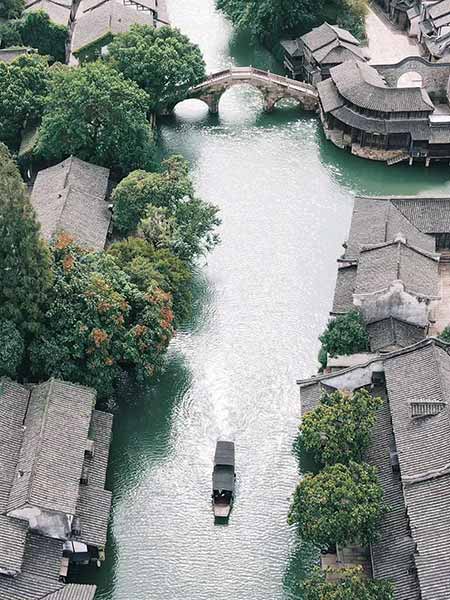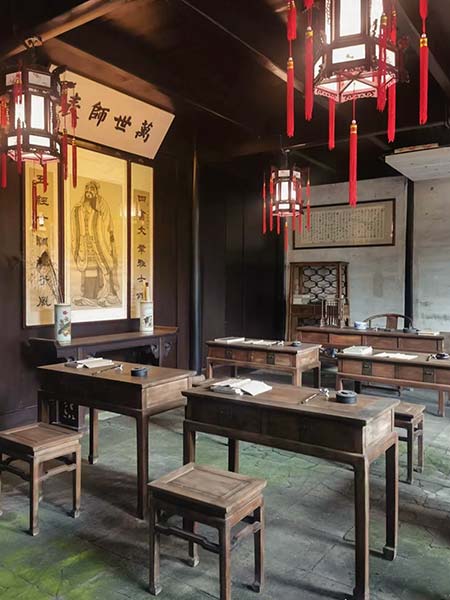The eight China ancient water towns in the lower reaches of the Yangtze River cover six ancient towns. They are the representatives of the old water town culture in China. It is well-known in ancient and modern times for its profound historical and cultural heritage, elegant and graceful water town style, and folk customs.
China ancient water towns top 8: Zhujiajiao



Zhujiajiao is located west of Shanghai, close to Dianshan Lake Scenic Area. The nine old streets of the ancient town are built along the river, and more than a thousand houses stand beside the river. Among them, the 300 meters long North Street, also known as “First-line Street,” was the best-preserved old street during the Ming and Qing Dynasties in the suburbs of Shanghai.
China ancient water towns top 7: Mudu



Mudu is one of China ancient water towns of the same age as Suzhou City, with a history of more than 2,500 years. There are 12 cultural relics protection units here. In 1983, it was listed as one of the 13 scenic spots in Taihu Lake. In Mudu, the cultural relics of the Ming and Qing Dynasties are extremely rich. Mudu accounts for half of the scenery described in the “Prosperous Suzhou” in the Qing Dynasty. There are more than 30 private gardens in the Ming and Qing Dynasties, and Mudu enjoys the reputation of being a “Garden Town.”
China ancient water towns top 6: Nanxun



Nanxun Ancient Town is located at the junction of Jiangsu and Zhejiang provinces. During the Ming and Qing Dynasties, she was already a famous silk town south of the Yangtze River. Nanxun is also an ancient town with rich humanities and a combination of Chinese and Western cultures. She is known as “the country of culture” and “the hometown of poetry and books.” Many celebrities have lived here.
China ancient water towns top 5: Luzhi



Like Mudu, Luzhi Ancient Town, located in Wuzhong District of Suzhou City, is also a China ancient cities of more than 2,500 years. Numerous lakes, ponds, and pools surround Luzhi. The appearance of the old town maintains the characteristics of traditional Chinese architecture. There are stone bridge of different styles, stone-paved streets, and various beautiful patterns are carved on the guardrails of the river. Houses look light and simple. The residential buildings along the road use the buildings in front as shops and the buildings in the back as living rooms or workshops. Taking advantage of the water resources of the Beijing-Hangzhou Grand Canal, the ancient residents built houses and engaged in production around the rivers and lakes. This way of life reflects the diligence and wisdom of the old Chinese people. The handicrafts made by women have extraordinary creativity, showing the unique value of Luzhi traditional costumes. The craftsmanship of women’s clothing has been listed as the first batch of intangible cultural heritage by the state.
China ancient water towns top 4: Tongli



Tongli Ancient Town is located in Wujiang District, Suzhou City. It is surrounded by five lakes, connected by 49 bridges, and a mesh of rivers divides the town into seven islands. In the ancient town, every family is close to the water, and every household is connected to a boat. The Song, Yuan, Ming, and Qing Dynasties bridges are well preserved. More than 400 years of cultural sites and relics still exist and can be seen everywhere. Deep residences, courtyards, and small gardens are scattered all over. Tongli Water Town is characterized by many buildings from Ming and Qing Dynasties. There are 38 garden houses of Ming and Qing dynasties, 47 temples, and hundreds of residences of gentry and wealthy and former residences of celebrities in the town.
China ancient water towns top 3: Xitang



Xitang Ancient Town is located at the junction of Jiangsu, Zhejiang, and Shanghai. It has a long history and is one of the birthplaces of ancient Wu and Yue cultures. In the Chunqiu Period and the Zhanguo Period, more than 2,000 years ago, this location was the border between Wu and Yue. At the beginning of the Tang Dynasty, more than 900 years ago, many villages were built here, and people built houses along the river and lived by the water. Later in the Nan Song Dynasty, the villages gradually became enormous, and markets were formed. In the Yuan Dynasty, a market town steadily formed, and business began to flourish. During the Ming and Qing Dynasties, it developed into a handicraft and commercial center. The most prosperous period of Xitang Town was the Ming Dynasty, more than 600 years ago. With the economic foundation of the fish, rice, silk, and the convenience of waterways, it has developed into a prosperous big market town. At that time, industries such as the rice market, food, and pottery were booming.
Top 2: Wuzhen



Wuzhen Ancient Town is located in the “Golden Triangle” of Jiangsu, Zhejiang, and Shanghai and belongs to the Taihu Lake Basin. With more than 7,000 years of civilization and a history of 1,300 years of founding, Wuzhen is a typical ancient water town in China’s south of the Yangtze River. In 2003, Wuzhen was awarded the Outstanding Achievement Award for Heritage Conservation in the Asia-Pacific Region by the United Nations. In 2006, Wuzhen was included in the United Nations World Cultural Heritage Preliminary List and China’s World Cultural Heritage Preliminary List Reset Catalog.
Top 1: Zhouzhuang



Zhouzhuang Ancient Town is located at the junction of Kunshan, Wujiang, and Shanghai. 14 ancient stone bridges built in Yuan, Ming, and Qing dynasties are well preserved on the well-shaped river. More than 800 aboriginal households live along the river, and most of the houses still maintain the architectural style of the Ming and Qing Dynasties.
Zhouzhuang buildings are mainly residential buildings in the south of the Yangtze River, among which there are more than 100 ancient houses in the Ming and Qing Dynasties. The old town is surrounded by water, and each waterway forms a “well” shape embedded in the ancient town. Zhouzhuang enjoys the reputation of “China’s No. 1 Water Town” globally and is included in the preliminary list of world cultured heritage by UNESCO.
Related Posts
18 activities to do in China’s most beautiful ancient town, Wuzhen

Home >> Ancient Water Towns >> 18 activities to do in China’s most beautiful ancient town, Wuzhen Wuzhen, an ancient water town in China, has a history of over 7,000 years of civilization and 1,300 years of town building. It…

